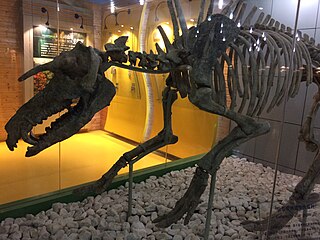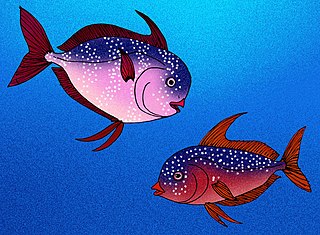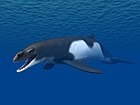
Cetotherium is an extinct genus of baleen whales from the family Cetotheriidae.

Kubanochoerus is an extinct genus of large, long-legged suid artiodactyl mammal from the Miocene of Eurasia and Africa.

Turkmenidae is an extinct family of lamprids from the Paleogene of the west-central Asia, in what was formerly the Peri-Tethys Ocean. They were small, disk-shaped fish that bore a strong resemblance to their closest living relatives, the opahs.
Joumocetus is a genus of extinct baleen whale in the family Cetotheriidae containing the single species Joumocetus shimizui. The species is known only from a partial skeleton found in Miocene age sediments of Japan.

Cetotheriidae is a family of baleen whales. The family is known to have existed from the Late Oligocene to the Early Pleistocene before going extinct. Although some phylogenetic studies conducted by Fordyce & Marx 2013 recovered the living pygmy right whale as a member of Cetotheriidae, making the pygmy right whale the only living cetotheriid, other authors either dispute this placement or recover Neobalaenidae as a sister group to Cetotheriidae.

Necrolestes is an extinct genus of mammals, which lived during the Early Miocene in what is now Argentine Patagonia. It is the most recent known genus of Meridiolestida, an extinct group of mammals more closely related to therians than to monotremes, which were the dominant mammals in South America during the Late Cretaceous. It contains two species, N. patagonensis and N. mirabilis; the type species N. patagonensis was named by Florentino Ameghino in 1891 based on remains found by his brother, Carlos Ameghino in Patagonia. Fossils of Necrolestes have been found in the Sarmiento and Santa Cruz Formations. Its morphology suggests that it was a digging, subterranean-dwelling mole-like mammal that fed on invertebrates.
This paleomammalogy list records new fossil mammal taxa that were described during the year 2012, as well as notes other significant paleomammalogy discoveries and events which occurred during that year.

Scaldicetus is an extinct genus of highly predatory macroraptorial sperm whale. Although widely used for a number of extinct physeterids with primitive dental morphology consisting of enameled teeth, Scaldicetus as generally recognized appears to be a wastebasket taxon filled with more-or-less unrelated primitive sperm whales.
Peripolocetus is a genus of balaenid baleen whale from the middle Miocene of Kern County, California.

Cetotheriopsis is a genus of extinct cetaceans of the family Cetotheriopsidae.

Tranatocetus is an extinct genus of mysticete from the late Miocene (Tortonian) of Jutland, Denmark. The type and only species is Tranatocetus argillarius.

Brandtocetus is a genus of cetotheriid mysticete in the subfamily Cetotheriinae. The type and only species is Brandtocetus chongulek from the late Miocene (Tortonian) of the Kerch Peninsula in Crimea.

Bubalus murrensis, also known as European water buffalo, is an extinct water buffalo species native to Europe during the Pleistocene epoch, possibly persisting into the Holocene.

Mithridatocetus is a genus of cetotheriid mysticete in the subfamily Cetotheriinae. Known specimens have been found in marine deposits in Crimea, Ukraine, and the Russian Caucasus.
Kurdalagonus is a genus of cetotheriid mysticete in the subfamily Cetotheriinae from the Miocene of the Russian Caucasus.
Eucetotherium is a genus of cetotheriid mysticete from Miocene (Tortonian) marine deposits in the Russian Caucasus.

Tiucetus is an extinct genus of cetotheriid baleen whale known from the Late Miocene Pisco Formation of Peru.
Herentalia is a genus of cetotheriid mysticete in the subfamily Herpetocetinae. Remains have been found in Late Miocene marine deposits in Belgium.
Zygiocetus is an extinct genus of cetotheriid mysticete in the subfamily Cetotheriinae. The type and only species is Zygiocetus nartorum, known from the Late Miocene (Messinian) of Adygea in the Russian Caucasus.
Otradnocetus is an extinct genus of baleen whale from the middle Miocene of the Russian Caucasus.














